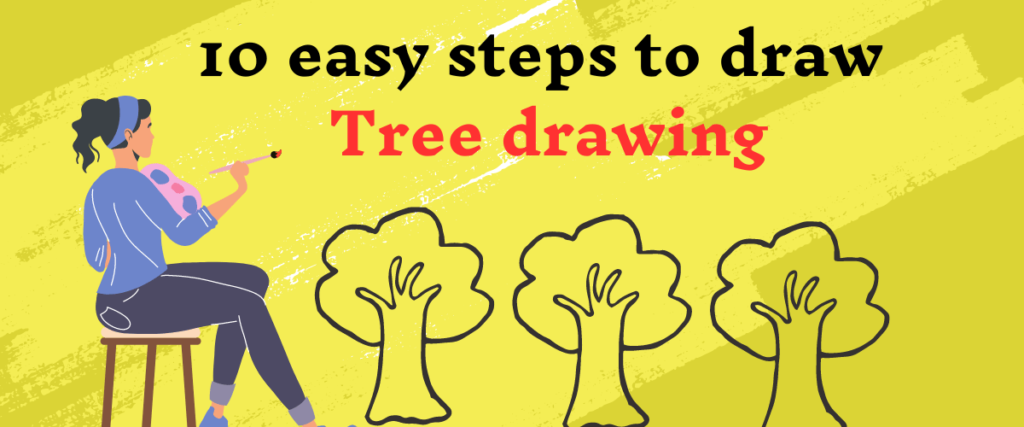
Tree drawing : Drawing a tree might seem challenging at first, but with a step-by-step approach, you can create a beautiful tree drawing with ease. Whether you’re a beginner or just looking to refine your skills, follow these ten simple steps to bring your tree to life on paper.
Step 1: Draw the Trunk of tree drawing
Start by drawing two parallel vertical lines. These lines will form the tree’s trunk. The width of these lines will determine how thick or thin your tree trunk appears.
Step 2: Add Roots of Tree drawing
At the bottom of the trunk, draw a few curved lines spreading outwards to represent the roots. This adds stability to your tree and makes it look more grounded.
Also Read : 7 easy steps to draw Asiatic Lion Drawing
Step 3: Shape the Canopy
Above the trunk, sketch an oval or a circle to outline the tree’s canopy. This shape serves as a guide for where the leaves will be.
Step 4: Draw Main Branches
From the top of the trunk, draw several branches extending outwards and upwards. These should be thicker near the trunk and taper as they extend.

Step 5: Add Sub-Branches
From each main branch, draw smaller branches extending out. These can be more irregular and should also taper towards the ends, mimicking the natural look of tree branches.
Step 6: Outline the Foliage
Around the branches, add a wavy, cloud-like line to represent the outer edge of the foliage. This line can follow the shape of the oval or circle you drew earlier.
Step 7: Texture the Trunk
Add some vertical lines or squiggles on the trunk to give it texture. This will make the trunk look more realistic and visually interesting.
Step 8: Detail the Canopy
Inside the wavy outline of the canopy, draw some smaller, irregular lines to represent clusters of leaves. This step adds depth and complexity to the tree’s foliage.

Step 9: Add Leaves
Draw individual leaves or clusters of leaves on some of the branches. These can be simple oval shapes and don’t need to be detailed, especially if you want a more stylized look.
Step 10: Shade and Final Touches
Add some shading to the trunk and branches to give the tree depth. You can use hatching or cross-hatching techniques for this. Also, add shadows beneath the canopy and roots to ground the tree. This final step will make your drawing pop and give it a three-dimensional feel.
With these ten easy steps, you can create a stunning tree drawing that showcases your artistic abilities. Remember, practice makes perfect, so don’t be afraid to experiment with different tree shapes and styles. Happy drawing!
By following these steps, you’ll be able to draw a variety of trees, from simple sketches to more detailed and realistic depictions. Keep practicing, and you’ll see your skills improve in no time.
What is the primary purpose of Tree drawing in computer science?
The primary purpose of drawing trees in computer science is to visually represent hierarchical data structures. Trees help illustrate parent-child relationships between nodes, making it easier to understand the organization, traversal, and manipulation of data.
How can you represent a binary tree visually, and what are the key components?
A binary tree can be represented visually by drawing a set of connected nodes. Each node typically contains a value and two pointers (or references) to its left and right children. The key components of a binary tree are:
Root: The topmost node.
Nodes: Individual elements containing data.
Edges: Lines connecting parent nodes to their children.
Leaves: Nodes with no children.
Subtrees: Portions of the tree that themselves are trees
What is an AVL tree, and how is it visually different from a regular binary tree?
An AVL tree is a self-balancing binary search tree where the difference in heights of the left and right subtrees of any node (called the balance factor) is at most one. Visually, an AVL tree looks similar to a binary tree but is balanced to ensure optimal performance for insertion, deletion, and lookup operations. This balance is maintained by performing rotations when nodes are inserted or deleted.
Describe how you would draw a B-tree and explain its significance in database indexing.
To draw a B-tree:
Start with a root node that can contain multiple keys.
Each node can have multiple children, ensuring that all leaf nodes remain at the same depth.
Internal nodes act as separators, guiding searches to the correct child nodes.
B-trees are typically drawn with nodes that can expand horizontally to show multiple keys and vertical connections to child nodes.
The significance of B-trees in database indexing lies in their ability to maintain sorted data in a way that allows for efficient insertion, deletion, and search operations, making them ideal for use in databases and file systems.
What is the difference between drawing a tree using a breadth-first approach versus a depth-first approach?
When drawing a tree using a breadth-first approach, nodes are drawn level by level, starting from the root and moving down to each subsequent level. This approach helps visualize the tree layer by layer.
In contrast, a depth-first approach draws the tree by exploring as far down a branch as possible before backtracking and exploring other branches. This can help visualize the complete path from the root to each leaf before moving on to other branches.
In summary:
Breadth-First: Draws the tree level by level horizontally.
Depth-First: Draws the tree branch by branch vertically.


1 thought on “10 easy steps to draw Tree drawing”